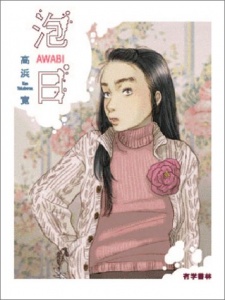Dec 21, 2020
So, here I am, starting what could be a little series of reviews on the often overlooked field of "nouvelle manga". For those who may not know about it, Nouvelle Manga (lit. "new manga") is a group... a movement? of Japanese and French artists whose sensitivities are often closer to those found in art-cinema rather than the usual in Eastern and Western pop culture. They set themselves apart from the fantasy stories that prime in French bande desinée, favouring stories that focus on the everyday lives of their characters in the fahion of josei manga. They maintain as well the black and white aesthetic of
...
Japanese comics, but the artistic styles tend to vary from the standard "manga" mold, sometimes even leaning towards photorealism (specially in the work of Frédéric Boilet, alma páter of the movement, who also writes the shortest story in this volume)
Kan Takahama's Awabi is comprised of six short stories revolving around different shapes of love. The first one, which gives its title to the volume and occupies roughly half of it, is by far the more complex and nuanced one, while the others work rather as snapshots, short anecdotes or excerpts from the lives of their protagonists. What kinds of love are depicted here? If one has to find one common denominator, it would be caring and respect. Takahama shows us characters who genuinely care for their loved ones, respect them, and who demonstrate it through actions; little actions more often than big ones, but always more than just words... even when the loving action is just letting your loved one go. And she also lets us get uncomfortable empathizing with some morally questionable individuals, or leaving us with a hanging question about what a certain character has said just before the story ended. Other times, she takes just a couple of pages to let us reflect with them, and that's the story. Takahama lets her characters speak like real people, open up to each other and disclose their past stories in a way that feels natural and not forced, even though they sometimes start as complete strangers; sometimes it's just easier to talk to someone who doesn't know you at all. The title story ends leaving one with the feeling that something is going to change in their protagonists' lives –specially Etsuko, the girl who appears unconscious at the pond; but it will still be a tough ride for all of them. Some sparks of tangle-comedy are a thankful addition to spice the mix.
Takahama's choice of finishing her pages with a clear pencil lineart and shading rather than the inks and dot hatches so common in manga gives the work a really unique personality, and a sense of intimacy and immediacy that fits really well with the themes of this volume. I haven't managed to see pages in Japanese for these works, but I'm wondering if the original dialogue baloons were done in pencils too. In the last stories, she experiments a little with digital color and shading, but keeping the linearts in pencil. Stylistically, she reminds a bit of authors from the late 70s and 80s like Satoshi Kon or Hayao Miyazaki, specially in their expressiveness, but with a slightly rougher finishing (the pencil choice, again). A person more versed in Western comics might as well find a little of Hugo Pratt's "writing with pictures" graphism. Having mentioned the expressiveness, I think that is one of the strong points here, particularly in the title story, where the artist goes through the whole spectrum of human emotions, depicted in a cartooney, yet realistic and at the same time distinctly Japanese way; with her clean and precise pencil finishings. Gorgeous.
Overall, Awabi is a pretty enjoyable read for anyone who is looking for something different in the vast world of manga. Even if it ends up not being your cup of tea, it is worth a taste
Reviewer’s Rating: 8
What did you think of this review?
Nice
 0
0
Love it
 0
0
Funny
 0
0
Confusing
 0
0
Well-written
 0
0
Creative
 0
0Show all

 (1).png)

















